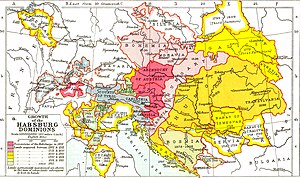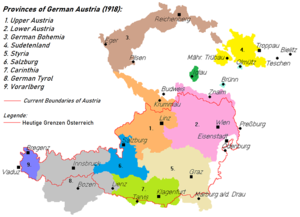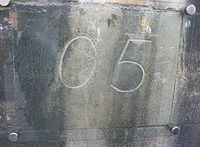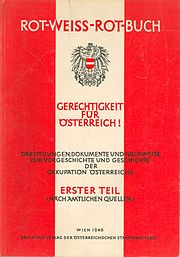Austrians
German: Österreicher | ||||
|---|---|---|---|---|
| Total population | ||||
c. 8–8.5 million
 | ||||
| Regions with significant populations | ||||
| 684,184[2] | ||||
| 345,620[3] | ||||
| 197,990[4] | ||||
| 67,000[5] | ||||
| 45,530[6] | ||||
| 39,600[5] | ||||
| 20,000[7] | ||||
| 18,200[5] | ||||
| 13,000[5] | ||||
| 12,500[5] | ||||
| 10,500[5] | ||||
Austrians ( March of Austria, corresponding roughly to the Vienna Basin in what is today Lower Austria .
Historically, Austrians were regarded as Austro-Hungarian Empire. After the collapse of the Austro-Hungarian Empire in 1918 at the end of World War I, Austria was reduced to a rump state and adopted and briefly used the name the Republic of German-Austria (German: Republik Deutschösterreich) in an attempt for union with Germany, but was forbidden due to the Treaty of Saint-Germain-en-Laye (1919). The First Austrian Republic was founded in 1919. Nazi Germany annexed Austria with the Anschluss in 1938.
After the defeat of Nazi Germany and the end of World War II in Europe, both the political ideology of pan-Germanism and the union with Germany have become associated with Nazism, resulting in Austrians developing their own separate and distinct national identity. Today, the vast majority of Austrians do not identify as German.[14][15][16] Name The House of Babenberg from AD 976.
During the 12th century, the Marcha Orientalis under the Babenbergs became independent of Bavaria. What is today known as Lower Austria corresponds to the Marcha Orientalis, while Upper Austria corresponds to the eastern half of the core territory of Bavaria (the western half forming part of the German state of Bavaria).
The adjective Austrian entered the English language in the early 17th century, at the time referring to Habsburg Austria in the sense of "members of the Austrian branch of the House of Habsburg" (the junior branch emerging from the dynastic split into Austrian and Spanish Habsburgs in 1521), but from the 18th century also "a native or inhabitant of Austria".[17] HistoryEarly historyCeltic tribes of the late La Tène period are labelled.The territory of what is today Austria in the Roman era was divided into Raetia, Noricum and Pannonia. Noricum was a Magyars. The site of Vienna had been settled since Celtic times (as Vindobona), but the city only rose to importance in the High Middle Ages as the chief settlement of the March of Austria (the March river just east of Vienna marks the ancient border between Francia and the Avars).
After the defeat of the Magyars at the March of Austria came to be the easternmost portion of the Holy Roman Empire, bordering on Moravia to the north and on the Kingdom of Hungary to the east.
As a consequence, the national character of the Austro-Bavarian speaking majority population of Austria throughout their early modern and modern history remained characterized by their neighbourhood to the West Slavs (Czechs, Slovaks) to the north, the South Slavs (Slovenes, Carinthian Slovenes, Burgenland Croats) to the south, and the Hungarians to the east.
The unification of the various territories of Austria outside of the March of Austria proper (i.e. parts of Bavaria, Swabia and Carinthia) was a gradual process of House of Babenberg during the 12th to 13th centuries, and under the House of Habsburg after 1278 and throughout the 14th and 15th centuries. The various populations of these territories were not unified under the single name of "Austrians" before the early modern period .
Early modern period The germanizing the leading classes of the Czech people as well. The common German identity of lands such as Carinthia, Styria, or Tyrol, and the ruling dynasty made it easier for these lands to accept the central government set up in Vienna in the mid-18th century.[citation needed ]
The term Austrian in these times was used for identifying subjects of the Domus Austriae, the House of Austria, as the dynasty was called in Europe, regardless of their ethnic ancestry. Although not formally a united state, the lands ruled by the Habsburgs would sometimes be known by the name "Austria". In reality they remained a disparate range of semi-autonomous states, most of which were part of the complex network of states that was the Maria Theresa of Austria and her son Joseph II .
After the Austro-Prussian war in 1866, Otto von Bismarck successfully unified the German Empire in 1871, which was Prussian-dominated, without the inclusion of Austria and the German Austrians.[18]
After Austria was excluded from Germany in 1866, the following year Austria joined Hungary as a dual empire known as the Transleithania ). The general public called them Austria, and in 1915, the non-parliamentary Cisleithanian government decreed to use this term officially, too.
19th-century nationalism The idea of grouping all German dualism .
The lands later called Cisleithania (except Napoleon Bonaparte. Although the years of peace after Napoleon's fall quickly saw German nationalism largely pushed out of the public political arena by reactionary absolutism, the Revolutions of 1848 established it as a significant political issue for a period of nearly hundred years.
 Political debate now centred on the nature of a possible future German state to replace the Confederation, and part of that debate concerned the issue of whether or not the Austrian lands had a place in the German polity. When Emperor Franz Joseph I ordered to build a monument in Vienna in 1860 to Archduke Charles, victor over Napoleon in the Battle of Aspern-Essling in 1809, it carried the dedication "To the persistent fighter for Germany's honour", to underline the Germanic mission of the House of Austria. The idea of uniting all ethnic Germans into one nation-state began to be challenged in Austria by the rise of Austrian nationalism, especially within the Christian Social Party that identified Austrians on the basis of their predominantly Catholic religious identity as opposed to the predominantly Protestant religious identity of the Prussians.[19] Habsburg influence over the German Confederation, which was strongest in the southern member states, was rivalled by the increasingly powerful Prussian state. Political manoeuvering by the Prussian chancellor Otto von Bismarck resulted in military defeat of the Austrians in the Austro-Prussian War of 1866 and the collapse of the Confederation, both effectively ending any future Austrian influence on German political events. When asked by Edward VII to abandon Austria-Hungary's alliance with Germany for co-operation with England, Franz Joseph replied "I am a German prince."[20][21] The Balkan Peninsula. Thereby the influence of pan-Germanism was diminished in the Habsburg territories, but as the term "Austrians" still was used supra-national, German-speaking Austrians considered themselves Germans (and were counted as such in the censuses). After Bismarck had excluded Austria from Germany, many Austrians faced a dilemma about their identity which prompted the Social Democratic Leader Otto Bauer to state that the dilemma was "the conflict between our Austrian and German character."[22] The state as a whole tried to work out a sense of a distinctively Austrian identity.
The Austro-Hungarian Empire created ethnic conflict between the German Austrians and the other ethnic groups of the empire. Many pan-German movements in the empire desired the reinforcement of an ethnic German identity and that the empire would collapse and allow for a quick annexation of Austria to Germany.[23][24] Although it was precisely because of Bismarck's policies that Austria and the German Austrians were excluded from Germany, many Austrian pan-Germans idolized him.[25] While the high bureaucracy of Austria and many Austrian army officers considered themselves "black-yellow" (the Habsburg colours), i.e. loyal to the dynasty, the term "German Austria" (Deutschösterreich) was a term used in the press to mean all the Austrian districts with an ethnic German majority among the inhabitants. Austrian pan-Germans such as Georg Ritter von Schönerer and his followers agitated against the "multi-national" Austro-Hungarian Empire and advocated for German Austria to join the German Empire.[26] Although many Austrians shared the same views, a lot of them still showed allegiance to the Habsburg monarchy and hoped for Austria to remain an independent country.[27] Although not as radical as Schönerer and his followers, populists such as Karl Lueger used anti-semitism and pan-Germanism as a form of populism to further their own political purposes.[28] World Wars The last year of World War I saw the collapse of Habsburg authority throughout an increasingly greater part of its empire. On October 16, 1918, emperor Karl I invited the nations of Austria to create national councils, with the aim to instigate a restructuring of the state under Habsburg rule. The nations followed the invitation (the Czechs had founded their national council already before the invitation) but ignored the will of the emperor to keep them in a restructured Austrian state. Their goal was total independence.  On October 21, the German members of the Austrian parliament, elected in 1911, met in Vienna to found the Provisional National Assembly of German Austria ("Provisorische Nationalversammlung für Deutschösterreich"). On October 30, 1918, they installed the first German Austrian government, leaving the question "monarchy or republic" open. ( German Austria ", reflecting the republic being the German part of the old Austria and showing the popular desire to unite with the new German republic. On November 12, 1918, the provisional national assembly voted for the republic and for unification with Germany with a large majority.
 The creation of the German Bohemians had not been allowed to become part of the new Austrian state, as well as in the southern part of Tyrol which now found itself part of Italy. In total, more than 3.5 million German-speaking Austrians were forced to remain outside the Austrian state.
The collapse of the empire caused an apparent struggle for some German Austrians between an "Austrian" and a "German" character.  By March 1938, with Nazi governments in control of both Berlin and Vienna, the country was annexed to Germany (Anschluss) as Ostmark. In 1942 the name was changed to the "Alpen-und Donau-Reichsgaue" ("Alpine and Danubian Gaue"), thus eradicating any links with a special Austrian past. Some of the most prominent Nazis were native Austrians, including Adolf Hitler, Ernst Kaltenbrunner, Arthur Seyss-Inquart, Franz Stangl, Otto Skorzeny, and Odilo Globocnik,[31] as were 40% of the staff at Nazi extermination camps.[32]
During the war, Austrians' infatuation with Germany faded as Austrian-born Moscow Declaration of 1943) the only Austrians who heard them were those secretly listening to enemy broadcasts ("Feindsender"), which was a criminal offence and heavily prosecuted.
Though the Allied forces treated Austria as a belligerent party in the war and maintained occupation of it after the Nazi capitulation, they accepted the Declaration of Independence which Austrian politicians had signed at Vienna's city hall on April 27, 1945, and they made the first national elections possible in the autumn of that year. By the end of 1945, Austria, under the supervision of the Allied Council in Vienna, had a democratic parliament and government again, acknowledged by all four allied occupation zones. The NSDAP members in Austria.[33] The sign of the Austrian resistance was O5, where the 5 stands for E and OE is the abbreviation of Österreich with Ö as OE.
Republic of Austria (1955 to present) The end of World War II in 1945 saw the re-establishment of an independent Austria, although the Allied Powers remained in occupation until 1955, when the Austrian State Treaty between Austria and them was signed to end occupation and to regain Austrian sovereignty. Immediately after 1945 the majority of Austrians still saw themselves as Germans, as a broader Austrian national identity took time to develop. In a 1956 survey, 46% of Austrians still considered themselves to be Germans.[34] Another survey carried out in 1964 revealed that only 15% of Austrians still considered themselves to be Germans.[34] In contrast, the Austrian political elite referred to their experiences in concentration camps and in prison, which had brought out a desire for the lost independence of the Austrian state. Kreissler (1993) writes: "It was not until after the (long dark) night of the Third Reich that Austrian identity was brought back to consciousness by resistance and exile".[35] Austrians developed a self-image unambiguously separate from their German neighbour. It was based on cultural achievements of the past, the Austria was considered a victim of Nazi Germany, although some historians call this a "big lie" and have challenged this statement.[36]
Unlike earlier in the 20th century, in 1987 only 6% of Austrians identified themselves as "Germans".[37] Today over 90% of the Austrians see themselves as an independent nation.[38][39] The logic of the existence of an independent Austrian state is no longer questioned as it was in the inter-war period. Proponents who recognize Austrians as a nation claim that Austrians have Celtic heritage, as Austria is the location of the first characteristically Celtic culture to exist.[40] It is said that Celtic Austria became culturally Romanized under Roman rule and later culturally Germanized after Germanic invasions.[40] Contemporary Austrians express pride in having Celtic heritage and Austria possesses one of the largest collections of Celtic artifacts in Europe.[41] Austria's multicultural history and geographical location has resulted in post-Soviet era immigration from Slovenia, the Czech Republic, Hungary, Slovakia, Romania, and Poland. As with neighbouring Germany, there has also been heavy immigration from Turkey and former Yugoslav states such as Croatia and Serbia. LanguageAustrians have historically spoken the German language. The sole official language at the federal level of Austria is German, and the standard used is called Carinthia, and Styria and the former including the dialects of Vienna, Burgenland, Upper Austria, and Lower Austria. The vast majority of Austrians are however able to speak Austrian Standard German in addition to their native dialect, as it is taught in all modern day schools.[citation needed ]
The minority languages Slovene, Croatian and Hungarian are spoken and officially recognized by some states of Austria.[citation needed] NaturalizationLike most of Central Europe, Austria has had high levels of immigration since the 1970s. As with Germany, the largest immigrant group are Turks. An estimated total of 350,000 ethnic Turks lived in Austria in 2010, accounting for 3% of the Austrian population.[42] The rate of dual citizenship). After 2007, the rate of naturalizations has decreased due to a stricter nationality law enacted by the Austrian legislature.[43]
During the 2000s, an average number of 27,127 foreign nationals per year was naturalized as Austrian citizens, compared to an average 67,688 children per year born with Austrian nationality.[44]
Today, the largest group of foreign nationals are Germans. As of January 2018 - 186,891 Germans lived in Austria.[45] Consequently, an increasing portion of Austrians is not descended from the historical populations of Austria. While the term "ethnic Austrian" has mostly been reserved for the context of overseas emigration from Austria ( Austrian Canadians etc.), it can more recently also be used to distinguish the indigenous population from the naturalized immigrant population.[46]
CultureMusicHungarian folk forms influenced Austrian music.
LiteratureComplementing its status as a land of artists, Austria has always been a country of great poets, writers, and novelists. It was the home of novelists Vienna circle .
CuisineAustrian cuisine, which is often incorrectly equated with Viennese cuisine, is derived from the cuisine of the Austro-Hungarian Empire. In addition to native regional traditions it has been influenced above all by German, Hungarian, Czech, Jewish, Italian and Polish cuisines, from which both dishes and methods of food preparation have often been borrowed. Goulash is one example of this. Austrian cuisine is known primarily in the rest of the world for its pastries and sweets.
ReligionThe majority of Austrians are traditionally (1903).Secularism has been on the rise since the 1980s. An estimated 66% of Austrians adhered to Roman Catholicism in 2009, compared to 78% in 1991 and 89% in 1961. There is a traditional Lutheran minority, accounting for 4% of the population in 2009 (down from 6% in 1961). An estimated 17% are nonreligious (as of 2005). immigration to Austria from Turkey and Yugoslavia during the 1990s to 2000s.
See alsoWikiquote has quotations related to Austrians.
ReferencesCitations
Bibliography
| ||||
